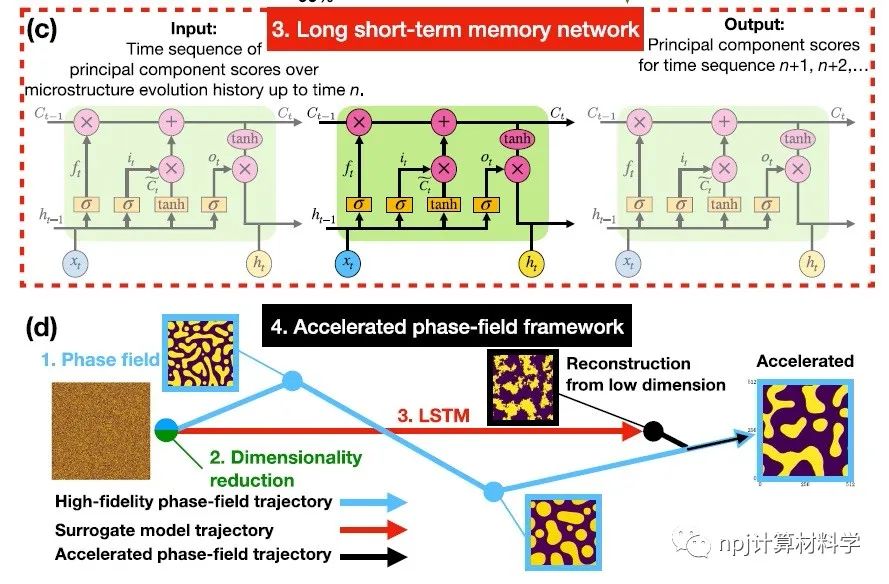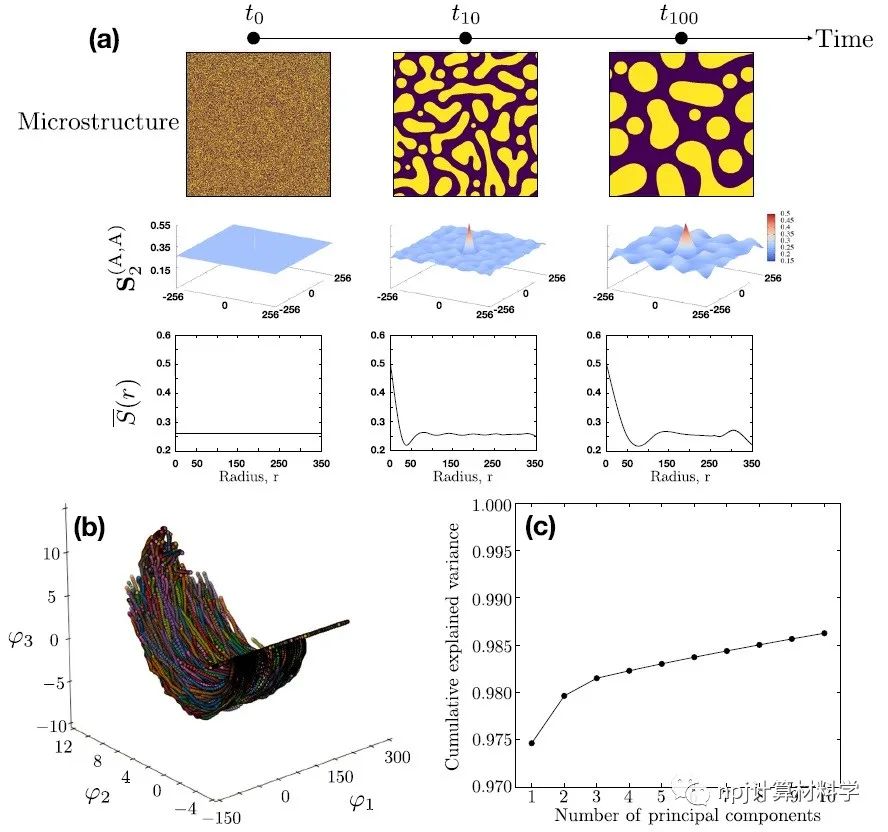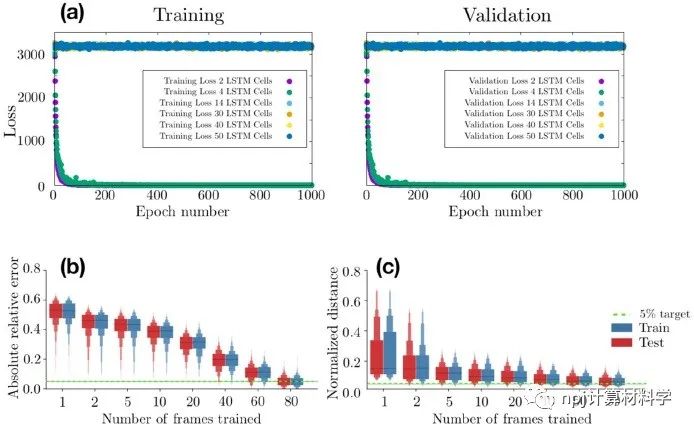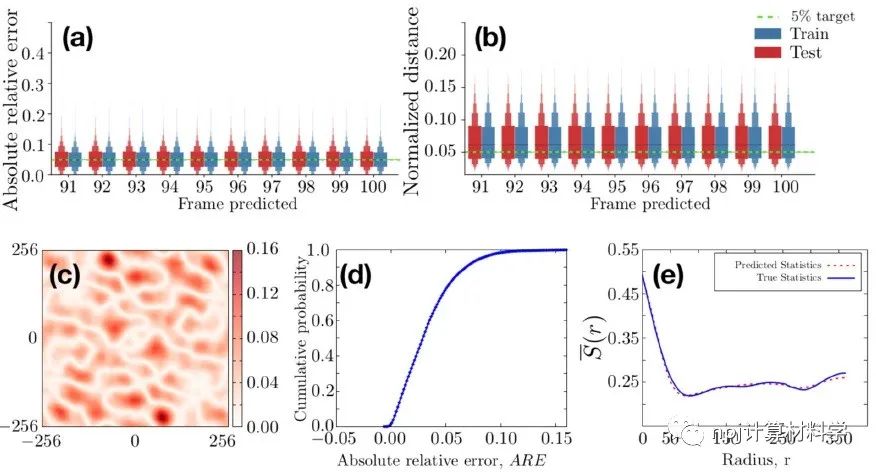机器学习+相场模拟:高效的介观模拟新方法
Posted npj计算材料学
tags:
篇首语:本文由小常识网(cha138.com)小编为大家整理,主要介绍了机器学习+相场模拟:高效的介观模拟新方法相关的知识,希望对你有一定的参考价值。
Fig. 1(a-c) Machine-learned surrogate model for accelerating phase-field based microstructure evolution predictions.
相场方法是一种介观尺度的计算方法,功能强大,用途广泛,可模拟各种物理、化学和生物系统的微观结构和相关特征的演化。但现有的高保真相场模型实际计算成本昂贵,需要高性能的计算资源和复杂的数值积分方案才能达到有用的精度。来自美国桑迪亚国家实验室集成纳米技术中心的Rémi Dingreville教授领导的团队开发了一个机器学习框架来高效、快速地预测复杂的微结构演化问题。通过采用长短期记忆(LSTM)神经网络学习长期模式和解决历史依赖性问题,作者将微结构演化问题重新表述为多变量时间序列问题。在这种情况下,神经网络能学习如何通过微结构随时间演化的低维描述来预测微结构的演化。他们发现这种机器学习的替代模型,可以在几分之一秒的时间内预测两相混合物在亚稳态分解时的非线性微观结构演化,与高保真相场模拟相比,准确性仅损失5%。作者表明,该替代模型轨迹作为经典高保真相场模型的输入数据时,可以加速相场模拟。作者的解决方案开辟了一条很有前途的道路,在尺度现象至关重要的问题中(如材料设计等演化问题),可利用他们加速的相场模拟来发现、求解和预测加工-微结构-性能关系。该文近期发表于npj ComputationalMaterials 7: 3 (2021).

Fig. 1(d) Machine-learned surrogate model for accelerating phase-field based microstructure evolution predictions.
Editorial Summary
Accelerated phase field simulation: A new approach to efficient mesoscopic simulation
The phase-field method is a powerful and versatile computational approachfor modeling the evolution of microstructures and associated properties for awide variety of physical, chemical, and biological systems. However, existinghigh-fidelity phase-field models are inherently computationally expensive,requiring high-performance computing resources and sophisticated numericalintegration schemes to achieve a useful degree of accuracy.

Fig. 2 Low-dimensional representation of the microstructure evolution.
A team leadby Prof. Rémi Dingreville from Center for Integrated Nanotechnologies, SandiaNational Laboratories, USA, developed and used a machine-learning framework to efficiently andrapidly predict complex microstructural evolution problems. By employing longshort-term memory (LSTM) neural networks to learn long-term patterns and solvehistory-dependent problems, the authors reformulate microstructural evolutionproblems as multivariate time-series problems. In this case, the neural networklearns how to predict the microstructure evolution via the time evolution ofthe low-dimensional representation of the microstructure. Their machine-learnedsurrogate model can predict the spinodal evolution of a two-phase mixture in afraction of a second with only a 5% loss in accuracy compared to high-fidelityphase-field simulations. This surrogate model trajectories can be used to acceleratephase-field simulations when used as an input to a classical high-fidelityphase-field model. Therefore, their framework opens a promising path forward touse accelerated phase-field simulations for discovering, understanding, andpredicting processing–microstructure–performance relationships in problemswhere evolutionary mesoscale phenomena are critical, such as in materialsdesign problems. This article was recently pblished in npj ComputationalMaterials 7: 3 (2021).

Fig. 3 LSTM architecture and calibration.
原文Abstract及其翻译
Accelerating phase-field-based microstructure evolution predictions via surrogate models trained by machine learning methods(通过机器学习方法训练的替代模型,加速基于相场的微结构演化预测)
David Montes de Oca Zapiain, James A. Stewart & Rémi Dingreville
Abstract The phase-field method is a powerful and versatile computational approach for modeling the evolution of microstructures and associated properties for a wide variety of physical, chemical, and biological systems. However, existing high-fidelity phase-field models are inherently computationally expensive, requiring high-performance computing resources and sophisticated numerical integration schemes to achieve a useful degree of accuracy. In this paper, we present a computationally inexpensive, accurate, data-driven surrogate model that directly learns the microstructural evolution of targeted systems by combining phase-field and history-dependent machine-learning techniques. We integrate a statistically representative, low-dimensional description of the microstructure, obtained directly from phase-field simulations, with either a time-series multivariate adaptive regression splines autoregressive algorithm or a long short-term memory neural network. The neural-network-trained surrogate model shows the best performance and accurately predicts the nonlinear microstructure evolution of a two-phase mixture during spinodal decomposition in seconds, without the need for “on-the-fly” solutions of the phase-field equations of motion. We also show that the predictions from our machine-learned surrogate model can be fed directly as an input into a classical high-fidelity phase-field model in order to accelerate the high-fidelity phase-field simulations by leaping in time. Such machine-learned phase-field framework opens a promising path forward to use accelerated phase-field simulations for discovering, understanding, and predicting processing–microstructure–performance relationships.

Fig. 4 Performance and predictability of LSTM-trained surrogate model.
摘要:相场方法是一种功能强大且用途广泛的计算方法,可用于模拟各种物理、化学和生物系统的微观结构和相关特征的演化。然而,现有的高保真相场模型本质上计算成本昂贵,需要高性能的计算资源和复杂的数值积分方案才能达到有用的精度。在研究中,我们提出了一种计算成本低廉、准确、数据驱动的替代模型,结合相场和历史依赖性机器学习技术,直接学习目标体系的微结构演化。我们把具有统计学代表性的、直接由相场模拟得到的低维微观结构描述,与时间序列多变量自适应回归曲线方法进行整合,或者与自回归算法或长短期记忆神经网络方法进行整合。神经网络训练的替代模型表现出最佳的性能,能在几秒钟内准确预测两相混合物在亚稳态的分解过程中所表现出的非线性微观结构演化,而无需对相场运动方程进行“即时”求解。研究还表明,我们的机器学习替代模型的预测结果可以直接作为输入,输入到一个经典的高保真相场模拟中,以通过时间跳跃加速高保真相场模拟。这种机器学习相场框架为利用加速的相场模拟来发现、求解和预测材料的加工-微结构-性能关系开辟了一条充满希望的道路。
Fig. 5 Accelerated phase-field predictions.
微信分享
以上是关于机器学习+相场模拟:高效的介观模拟新方法的主要内容,如果未能解决你的问题,请参考以下文章